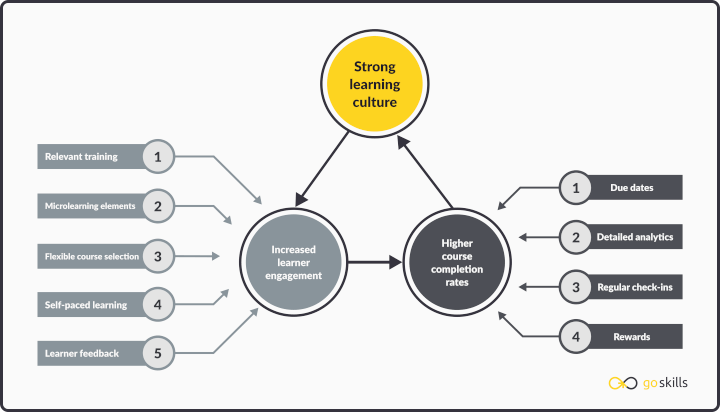Low completion rates can undermine corporate learning and development (L&D) programs. Digital learning platforms like GoSkills provide tools for creating flexible, accessible training. Yet, motivating learners to finish courses remains a challenge.
Fortunately, effective employee engagement strategies can change that. This article examines best practices used by Hampton Roads Transit (HRT) to revitalize its employee training strategies.
Develop leadership excellence
Get Hampton Roads Transit's learning success formula
The importance of fostering an engaged workforce
Engagement in online learning goes beyond mere participation—it reflects how learners interact with course materials, instructors, and peers. A key indicator of this engagement is the course completion rate, which shows not only attendance but also the attainment of learning objectives.
High completion rates
High completion rates suggest that learners are motivated and successfully achieving their goals. They signal effective learning experiences that drive both compliance and skill development.
Low completion rates
Low completion rates can reveal a disconnect from the content, a lack of motivation, or obstacles to understanding. This is especially critical in compliance or regulatory training, where a 100% completion rate is often mandatory.
Why it matters
Completion rates serve two essential purposes:
- They ensure that mandatory training requirements are met.
- They act as a metric for assessing whether an organization is successfully developing its workforce and maintaining a competitive edge.
The COVID-19 pandemic further highlighted these challenges. While digital learning offers flexibility and cost-effectiveness, some online courses reported completion rates during that time as low as 12%, underlining the urgent need for improved employee engagement strategies.
Examples of successful employee engagement from Hampton Roads Transit
Hampton Roads Transit (HRT), a public transportation service in Virginia, USA, serves as a prime example of an organization that has effectively tackled these challenges. With approximately 1,000 employees, HRT embarked on a mission to revitalize its training and development strategy by leveraging its learning management system (LMS) to boost employee engagement and course completion rates.
Identifying training needs and objectives
The organization’s journey began with the identification of a critical need for a structured training program aimed at enhancing leadership skills within the team. This need was coupled with the realization that many managers lacked formal training in essential technical skills, such as Microsoft Office applications, which were pivotal for their daily tasks. Additionally, there was a clear desire among team members for professional and personal development opportunities.
Strategic execution of the L.E.A.D. training program
To address these needs, HRT utilized the GoSkills LMS to launch the Leadership Education and Development Program (L.E.A.D.). This initiative was marked by a strategic approach that included performing a skills gap analysis, assigning relevant courses with completion deadlines, and enabling managers to track progress through the LMS.
A standout feature of the program was the flexibility it offered learners to enroll in any course within the GoSkills library that interested them, beyond their assigned curriculum. This aligns with the current global shift toward the self-guided style of learning experience platforms.
Develop leadership excellence
Get Hampton Roads Transit's learning success formula
Boosting engagement through practical learning and flexibility
A significant shift in HRT’s training approach was moving away from traditional, often tedious, learning methods to more engaging and practical ones. The organization recognized that learning effectiveness was greatly enhanced when the material was directly applicable to the learners’ job roles and when it provided tangible benefits to their daily tasks. This approach was supported by microlearning principles, where content is delivered in small, manageable segments that fit easily into the learners’ schedules.
Maximizing the platform's features
A pivotal aspect of HRT’s success was its adept use of the platform's features to create a personalized and interactive learning environment. This included gamification elements such as badges and coins to motivate learners, as well as comprehensive analytics that allowed for the tracking of progress and engagement levels. These features not only made learning more enjoyable but also provided valuable data to further refine and target the training programs.
Action plan results and implications
The results of HRT’s revamped L&D strategy were compelling. The organization witnessed a remarkable increase in course completion rates, with learners in the L.E.A.D. program achieving a 69% completion rate, significantly higher than the average for online courses. This success was attributed to a combination of factors, including the relevance and practical application of the course content, the flexibility offered to learners, and the effective use of LMS features to track and encourage progress.
Employee engagement best practices
Engaging employees in online learning and achieving high completion rates is a complex challenge that requires a multifaceted approach. Hampton Roads Transit’s experience demonstrates that through strategic planning, the smart use of technology, and taking into account what learners need and prefer, organizations can not only boost L&D effectiveness but also fortify their learning culture, further enhancing overall employee engagement.
An engaged employee is more likely to be an engaged learner.

The case of Hampton Roads Transit provides several key takeaways for organizations looking to enhance their online training programs. These include:
- Relevance and practicality: Courses that are directly applicable to the learners’ job roles and offer immediate benefits tend to engage learners more effectively.
- Flexibility and choice: Allowing learners to choose courses that interest them or are relevant to their career goals can significantly increase motivation and completion rates.
- Effective use of LMS features: Leveraging LMS tools such as gamification, analytics, and personalized learning paths can greatly enhance the learning experience and outcomes.
- Microlearning: Adopting microlearning principles, where content is delivered in short, manageable segments, can fit learning into busy schedules and improve retention.
- Feedback and adaptation: Continuous gathering of learner feedback and adaptation of training programs based on this feedback and data analytics are crucial for sustained success.
Boosting engagement and completion rates on your team
Are you tasked with designing effective elearning programs for your employees? Then the challenges faced by Hampton Roads Transit may resonate with you.
Your effectiveness as a leader is reflected in your employees’ learning outcomes and job satisfaction. Instead of relying on random methods, adopt proven employee engagement strategies to create an environment where employees feel valued and highly engaged.
By implementing these best practices, you can improve employee engagement, boost productivity, and enhance your organization’s training and development efforts, ultimately reducing turnover and strengthening your workplace culture.
Looking for more engagement ideas? Learn how Balsam Brands fosters a learning culture across continents.
Experience the difference
Start transforming the way your organization learns — no credit card required. Get started in minutes!
Create your free account nowThis study was published as an academic paper.
Buckley, C., & Castro Jorge, M. F. (2024). Best Practices for Increasing Employee Engagement and Completion Rates in Online Courses: A Case Study on Creating a Culture of Learning. International Journal of Advanced Corporate Learning (iJAC), 17(1), pp. 4–12.




